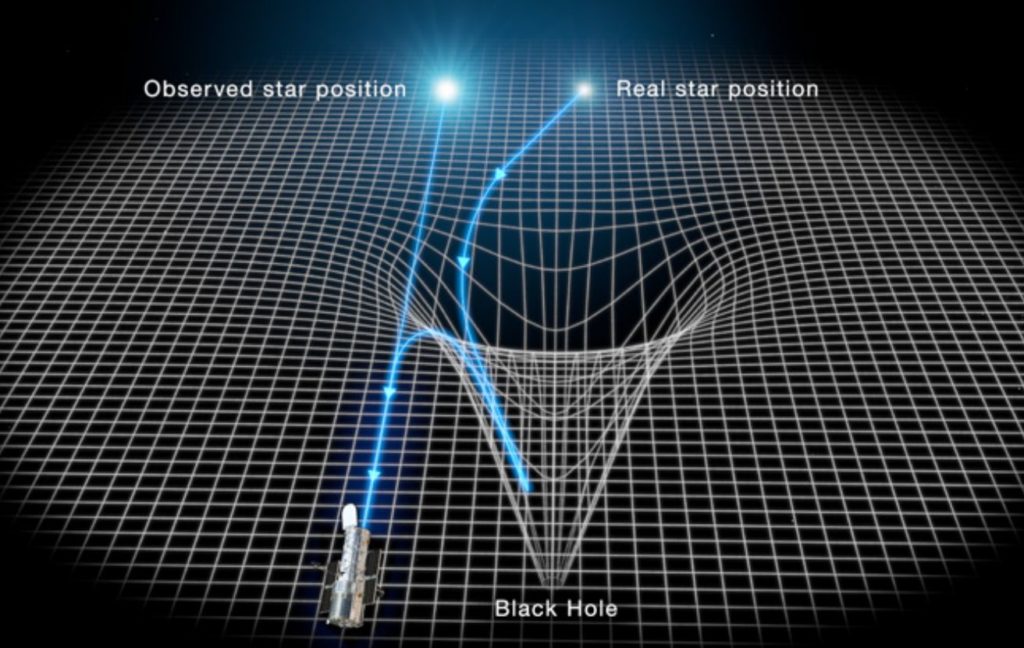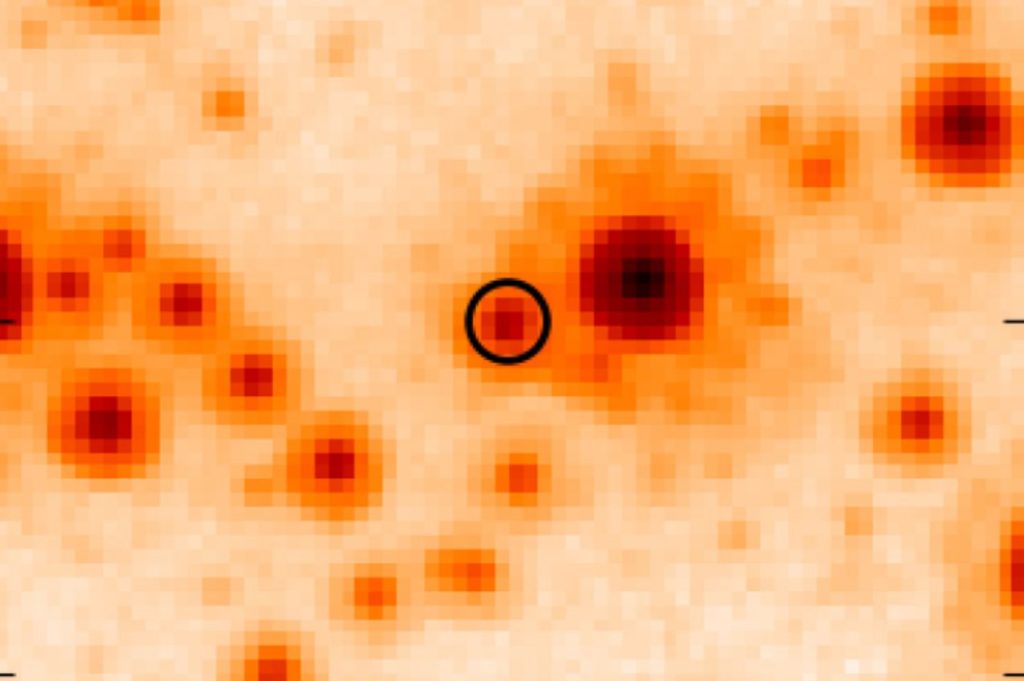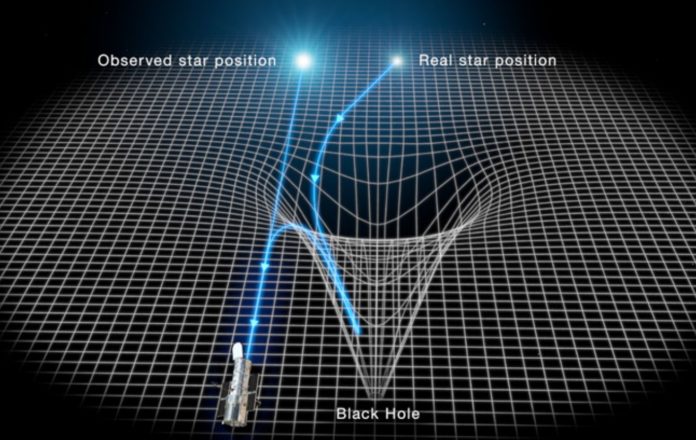Using gravitational microlensing, a team led by astronomers from the University of California, Berkeley may have identified the first free-floating black hole in the Milky Way galaxy. They hope to detect many more ghost stars with new observations.
If, as researchers believe, big star deaths leave behind black holes, there should be hundreds of millions of them distributed over the Milky Way galaxy. The issue is that isolated black holes are undetectable.
Now, a group of astronomers from the University of California, Berkeley, has observed for the first time what may be a lonely and invisible black hole by monitoring the brightening of a distant star as its light was distorted by the object’s strong gravitational field — a phenomenon known as gravitational microlensing.

The team, led by UC Berkeley assistant professor of astronomy Jessica Lu and graduate student Casey Lam, calculates that the mass of the invisible compact object is between 1.6 and 4.4 times that of the sun. The UC Berkeley researchers warn that the object could be a neutron star rather than a black hole because astronomers believe the relic of a dead star must be heavier than 2.2 solar masses in order to collapse to a black hole. Neutron stars are also dense, compact objects, but their gravity is counterbalanced by internal neutron pressure, which prevents them from collapsing further into black holes.
Regardless of whether the object is a black hole or a neutron star, it is the first dark stellar remnant — a stellar “ghost” — to be spotted travelling across the galaxy alone.
“This is the first free-floating black hole or neutron star discovered with gravitational microlensing,” Lu remarked. “With microlensing, we’re able to probe these lonely, compact objects and weigh them. I think we have opened a new window onto these dark objects, which can’t be seen any other way.”
Determining the number of these compact objects in the Milky Way galaxy will aid astronomers in better understanding the evolution of stars — specifically, how they die — and our galaxy, as well as reveal whether any of the unseen black holes are primordial black holes, which some cosmologists believe were produced in large quantities during the Big Bang.

The Astrophysical Journal Letters will publish Lam, Lu, and their team’s analysis. In the analysis, the team found four other microlensing events that were not caused by a black hole. However, two of them were likely caused by a white dwarf or a neutron star. The scientists also determined that the galaxy’s expected population of black holes is 200 million, which is similar to what most theorists projected.
Different interpretations of the same data
Notably, a different team from the Space Telescope Science Institute (STScI) in Baltimore looked at the same microlensing event and says that the compact object has a mass closer to 7.1 solar masses and is definitely a black hole. The Astrophysical Journal has approved an article by the STScI team, lead by Kailash Sahu, that describes the analysis.
Both groups applied the same data: photometric measurements of the brightening of the distant star as its light was distorted or “lensed” by the super-compact object, and astrometric measurements of the shifting of the distant star’s location in the sky as a result of gravitational distortion by the lensing object. Two microlensing surveys, the Optical Gravitational Lensing Experiment (OGLE) and the Microlensing Observations in Astrophysics (MOA) experiment, provided the photometric data for this study. NASA’s Hubble Space Telescope provided the astrometric data. STScI is in charge of the telescope’s science program and science operations.
MOA-2011-BLG-191 and OGLE-2011-BLG-0462, or OB110462, are the two names for the same object captured by both microlensing surveys.
The combination of astrometric data allowed the two teams to establish the compact object’s mass and distance from Earth. Surveys like these find roughly 2,000 brightened stars via microlensing each year in the Milky Way galaxy. It is believed to be between 2,280 and 6,260 light years (700-1920 parsecs) away, in the direction of the Milky Way’s core and near the huge bulge that surrounds the galaxy’s central big black hole, according to the UC Berkeley-led research.
It is estimated to be 5,153 light years (1,580 parsecs) distant by the STScI group.
In search of a needle in a haystack
Lu and Lam became interested in the object for the first time in 2020, after the STScI team tentatively concluded that five microlensing events observed by Hubble — all of which lasted more than 100 days and therefore could have been black holes — may not have been caused by compact objects after all.
Lu, who has been searching for free-floating black holes since 2008, hoped the data would help her better estimate their number in the galaxy, which is estimated to be between 10 million and 1 billion. Star-sized black holes have only been discovered as part of binary star systems so far. X-rays, which are created as material from the star falls onto the black hole, or modern gravitational wave detectors, which are sensitive to mergers of two or more black holes, can be spotted in binaries. However, such occurrences are uncommon.
“Casey and I saw the data and we got really interested. We said, ‘Wow, no black holes. That’s amazing,’ even though there should have been ,” Lu replied, “And so, we started looking at the data. If there were really no black holes in the data, then this wouldn’t match our model for how many black holes there should be in the Milky Way. Something would have to change in our understanding of black holes — either their number or how fast they move or their masses .”
When Lam looked at the photometry and astrometry for the five microlensing events, she was shocked to find one of them, OB110462, had compact object characteristics: The lensing object appeared black and thus not to be a star; the stellar brightening lasted about 300 days; and the distortion of the background star’s position persisted for the same amount of time.
Lam said that the length of the event was the main clue. She demonstrated in 2020 that looking for very long events was the best technique to find black hole microlenses. According to her, black holes account for only 1% of measurable microlensing events, so looking at all of them would be like looking for a needle in a haystack. However, according to Lam, around 40% of microlensing occurrences lasting more than 120 days are likely to be black holes.
“How long the brightening event lasts is a hint of how massive the foreground lens bending the light of the background star is,” Lam explained. “Long events are more likely due to black holes. It’s not a guarantee, though, because the duration of the brightening episode not only depends on how massive the foreground lens is, but also on how fast the foreground lens and background star are moving relative to each other. However, by also getting measurements of the apparent position of the background star, we can confirm whether the foreground lens really is a black hole .”
According to Lu, OB110462’s gravitational influence on the light of the background star lasted an incredibly long time. The star brightened for about a year until it reached its peak in 2011, then dimmed for about a year before returning to normal.
More data is needed to distinguish between a black hole and a neutron star.
For Lu and Lam to be sure that OB110462 was caused by a super-dense object, they asked Hubble for more astrometric data. Some of this data came in October of last year. The new data revealed that the shift in the star’s position caused by the lens’ gravitational field may still be seen 10 years after the occurrence. The Hubble Space Telescope will observe the microlens again in the fall of 2022.
According to the new evidence, OB110462 is most likely a black hole or neutron star.
The fact that the astrometric and photometric data yield different measurements of the relative movements of the foreground and background objects, Lu and Lam believe, is to blame for the two teams’ divergent conclusions. The astrological analysis of the two teams also differs. The UC Berkeley-led team claims that it is currently impossible to tell whether the object is a black hole or a neutron star, but that more Hubble data and enhanced analysis will help them settle the discrepancy in the future.
“As much as we would like to say it is definitively a black hole, we must report all allowed solutions. This includes both lower mass black holes and possibly even a neutron star ,” Lu added.
“If you can’t believe the light curve, the brightness, then that says something important. If you don’t believe the position versus time, that tells you something important,” Lam added. “So, if one of them is wrong, we have to understand why. Or the other possibility is that what we measure in both data sets is correct, but our model is incorrect. The photometry and astrometry data arise from the same physical process, which means the brightness and position must be consistent with each other. So, there’s something missing there. “
The velocity of the super-compact lensing object was likewise calculated by both teams. The Lu/Lam team discovered a rather slow speed of less than 30 km/s. The STScI team discovered an exceptionally high velocity of 45 km/s, which they interpreted as the result of the alleged black hole receiving an extra kick from the supernova that created it.
Lu sees her team’s low velocity estimate as confirming a novel notion that black holes are formed by failed supernovas that don’t make a bright splash in the universe or give the resulting black hole a kick, rather than supernovas, which are the current assumption.
Image Credit: STScI/NASA/ESA
You were reading: Think They Have Captured First Lonely, Invisible Black Hole in the Milky Way galaxy
